Sled dog


Sled dogs have been used in the Arctic for at least 9,000 years and were important for transportation in Arctic areas until the introduction of semi-trailer trucks, snowmobiles and airplanes in the 20th century, hauling supplies in areas that were inaccessible by other methods. They were used with varying success in the explorations of both poles, as well as during the Alaskan gold rush. Sled dog teams delivered mail to rural communities in Alaska and northern Canada. Sled dogs today are still used by some rural communities, especially in areas of Alaska and Canada and throughout Greenland. They are used for recreational purposes and racing events, such as the Iditarod Trail and the Yukon Quest.
History
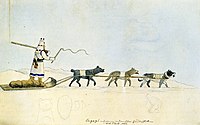

Sled dogs are used in Canada, Lapland, Greenland, Siberia, Chukotka, Norway, Finland, and Alaska.[1]
Eurasia
Siberia
A 2017 study showed that 9,000 years ago the domestic dog was present at what is now Zhokhov Island, Arctic northeastern Siberia, which at that time was connected to the mainland. The dogs were selectively bred as either sled dogs or hunting dogs, implying that a sled dog standard and a hunting dog standard co-existed. The optimal maximum size for a sled dog is 20–25 kg based on themo-regulation, and the ancient sled dogs were between 16–25 kg. The same standard has been found in the remains of sled dogs from this region 2,000 years ago and in the modern Siberian Husky breed standard. Other dogs were more massive at 30 kg and appear to be dogs that had been crossed with wolves and used for polar bear hunting. At death, the heads of the dogs had been carefully separated from their bodies by humans and is thought to be for ceremonial reasons.[2]
Greenland
The Danish military act as the police in Greenland and conduct sled dog patrols during the winter, which also record all sighted wildlife. The number of patrols averaged 14,876 km/year during 1978-1998. By 2011, the arctic wolf had re-populated eastern Greenland from their reserve in the northeast through following these dog-sled patrols over distances of up to 560 kilometers.[3]
North America
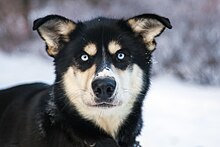
Historical references of the dogs and dog harnesses that were used by Native American cultures date back to before European contact.[4] The use of dogs as draft animals was widespread in North America.[4] There were two main kinds of sled dogs; one kind was kept by coastal cultures, and the other kind was kept by interior cultures such as the Athabascan Indians.[4] These interior dogs formed the basis of the Alaskan Husky.[4] Russian traders following the Yukon River inland in the mid-1800s acquired sled dogs from the interior villages along the river.[4] The dogs of this area were reputed to be stronger and better at hauling heavy loads than the native Russian sled dogs.[4]
The Alaskan Gold Rush brought renewed interest in the use of sled dogs as transportation.[4] Most gold camps were accessible only by dogsled in the winter.[5] "Everything that moved during the frozen season moved by dog team; prospectors, trappers, doctors, mail, commerce, trade, freighting of supplies … if it needed to move in winter, it was moved by sled dogs."[4] This, along with the dogs' use in the exploration of the poles, led to the late 1800s and early 1900s being nicknamed the "Era of the Sled Dog".[6]
Sled dogs were used to deliver the mail in Alaska during the late 1800s and early 1900s.[7] Malamutes were the favored breed, with teams averaging eight to ten dogs.[7] Dogs were capable of delivering mail in conditions that would stop boats, trains, and horses.[7] Each team hauled between 230 and 320 kilograms (500 and 700 lb) of mail.[7] The mail was stored in waterproofed bags to protect it from the snow.[7] By 1901, dog trails had been established along the entirety of the Yukon River.[7] Mail delivery by dog sled came to an end in 1963 when the last mail carrier to use a dog sled, Chester Noongwook of Savoonga, retired.[7] He was honored by the US Postal Service in a ceremony on St. Lawrence Island in the Bering Sea.[7]
Airplanes took over Alaskan mail delivery in the 1920s and 1930s.[4] In 1924, Carl Ben Eielson flew the first Alaskan airmail delivery.[8] Dogsleds were used to patrol western Alaska during World War II.[8] Highways and trucking in the 40s and 50s, and the snowmobile in the 50s and 60s, contributed to the decline of the working sled dog.[4]
Recreational mushing came into place to maintain the tradition of dog mushing.[4] The desire for larger, stronger, load-pulling dogs changed to one for faster dogs with high endurance used in racing, which caused the dogs to become lighter than they were historically.[4][9] Americans then began to import Siberian Huskies to increase the speed of their own dogs, presenting "a direct contrast to the idea that Russian traders sought heavier draft-type sled dogs from the Interior regions of Alaska and the Yukon less than a century earlier to increase the hauling capacity of their lighter sled dogs."[4]
Outside of Alaska, dog-drawn carts were used to haul peddler's wares in cities like New York.[10]
Nome, Alaska and the Iditarod

In 1925, there was a diphtheria outbreak in Nome, Alaska. There was not enough serum in Nome to treat the number of people infected by the disease.[8] There was serum in Nenana, but the town was 1,100 kilometres (700 miles) away, and inaccessible except by dog sled.[8] A dog sled relay was set up by the villages between Nenana and Nome, and 20 teams worked together to relay the serum to Nome.[8] The serum reached Nome in six days.[8]
The Iditarod Trail was established on the path between these two towns.[8] It was known as the Iditarod Trail because, at the time, Iditarod was the largest town on the trail.[8] During the 1940s, the trail fell into disuse.[8] However, in 1967, Dorothy Page, who was conducting Alaska's centennial celebration, ordered 14 kilometres (9 miles) of the trail to be cleared for a dog sled race.[8] In 1972, the US Army performed a survey of the trail, and in 1973 the Iditarod was established by Joe Redington, Sr.[8][11] The race was won by Dick Wilmarth, who took three weeks to complete the race.[8]
The modern Iditarod is a 1,800-kilometre-long (1,100 mi) endurance sled dog race.[11] It usually lasts for ten to eleven days, weather permitting.[11] It begins with a ceremonial start in Anchorage, Alaska on the morning of the first Saturday in March, with mushers running 32 kilometres (20 miles) to Eagle River along the Alaskan Highway, giving spectators a chance to see the dogs and the mushers.[12] The teams are then loaded onto trucks and driven 48 kilometres (30 miles) to Wasilla for the official race start in the afternoon.[12] The race ends when the last musher either drops out of the race or crosses the finish line in Nome.[11] The winner of the race receives a prize of US$50,000.[11] It has been billed as the "World Series of mushing events"[13] and "The Last Great Race on Earth".[14]
Antarctica


The first Arctic explorers were men with sled dogs.[15] Due to the success of using sled dogs in the Arctic, it was thought they would be helpful in the Antarctic exploration as well, and many explorers made attempts to use them.[15] Sled dogs were used until 1992, when they were banned from Antarctica by the Protocol on Environmental Protection to the Antarctic Treaty.[15][why?]
Carsten Borchgrevink used sled dogs (Samoyeds) in Antarctica during his Southern Cross Expedition (1898–1900), but it was much colder than expected at Cape Adare.[15] The dogs were used to working on snow, not on ice, in much milder temperatures.[15] The dogs were also inadequately fed, and eventually all of the dogs died.[15]
Erich von Drygalski used sled dogs in his 1901–1903 expedition, and fared much better because his dogs were used to the cold and he hired an experienced dog handler.[15] His dogs were allowed to breed freely and many had to be shot because there was no room on the ship to take them home.[15] Many that were not shot were left behind on the Kerguelen Islands.[15]
Otto Nordenskjold intended to use sled dogs in his 1901–1904 expedition, but all but four of his dogs died on the journey south.[15] He picked up more dogs in the Falklands, but these were all killed upon his arrival by Ole Jonassen's huskies, as Ole had not bothered to tether his dogs.[15] These huskies were later able to pull 265 kilograms (584 pounds) over 29 kilometres (18 miles) in three and a half hours.[15]
Robert Falcon Scott brought twenty Samoyeds with him.[15] The dogs struggled under the conditions Scott placed them in, with four dogs pulling heavily loaded sleds through 45-centimetre-deep (18 in) snow with bleeding feet.[15] Scott blamed their failure on rotten dried fish.[15]
Douglas Mawson and Xavier Mertz were part of the Far Eastern Party, a three-man sledging team with Lieutenant B.E.S. Ninnis, to survey King George V Land, Antarctica. On 14 December 1912 Ninnis fell through a snow-covered crevasse along with most of the party's rations, and was never seen again. Their meagre provisions forced them to eat their remaining dogs on their 315-mile (507 km) return journey. Their meat was tough, stringy and without a vestige of fat. Each animal yielded very little, and the major part was fed to the surviving dogs, which ate the meat, skin and bones until nothing remained. The men also ate the dog's brains and livers. Unfortunately eating the liver of sled dogs produces the condition hypervitaminosis A because canines have a much higher tolerance for vitamin A than humans do. Mertz suffered a quick deterioration. He developed stomach pains and became incapacitated and incoherent. On 7 January 1913, Mertz died. Mawson continued alone, eventually making it back to camp alive.[16]
Roald Amundsen's expedition was planned around 97 sled dogs.[15] On his first try, two of his dogs froze to death in the −56 °C (−69 °F) temperatures.[15] He tried a second time and was successful.[15] Amundsen was covering 27 kilometres (17 miles) a day, with stops every 4.8 kilometres (3 miles) to build a cairn to mark the trail.[15] He had 55 dogs with him, which he culled until he had 14 left when he returned from the pole.[15] On the return trip, a man skied ahead of the dogs and hid meat in the cairns to encourage them to run.[15]
Sled dog breeds
The original sled dogs were chosen for size, strength and stamina, but modern dogs are bred for speed and endurance [4][9] Most sled dogs weigh around 25 kilograms (55 lb),[17] but they can weigh as little as 16 kilograms (35 lb), and can exceed 32 kilograms (71 lb).[9] Sled dogs have a very efficient gait,[17] and "mushers strive for a well balanced dog team that matches all dogs for both size (approximately the same) and gait (the walking, trotting or running speeds of the dogs as well as the 'transition speed' where a dog will switch from one gait to another) so that the entire dog team moves in a similar fashion which increases overall team efficiency."[9] They can run up to 45 km/h (28 mph).[18] Because of this, sled dogs have very tough, webbed feet with closely spaced toes.[9] Their webbed feet act as snow shoes.[15]
A dog's fur depends on its use. Freight dogs should have dense, warm coats to hold heat in,[9] and sprint dogs have short coats that let heat out.[1] Most sled dogs have a double coat, with the outer coat keeping snow away from the body, and a waterproof inner coat for insulation.[18] In warm weather, dogs may have problems regulating their body temperature and may overheat.[9] Their tails serve to protect their nose and feet from freezing when the dog is curled up to sleep.[15] They also have a unique arrangement of blood vessels in their legs to help protect against frostbite.[15]
Appetite is a big part of choosing sled dogs; picky dogs off trail may be pickier on the trail.[9] They are fed high-fat diets, and on the trail may eat oily salmon or blubbery sea mammals.[15] Sled dogs also must not be overly aggressive with other dogs.[9]
Breeds

Alaskan husky
The most commonly used dog in dog sled racing,[17] the Alaskan husky is a mongrel[4] bred specifically for its performance as a sled dog.[1] They first came into existence in the late 1800s.[4] Occasionally, Alaskan huskies are referred to as Indian Dogs, because the best ones supposedly come from Native American villages in the Alaskan and Canadian interiors.[1] They weigh between 18 and 34 kilograms (40 and 75 lb) and may have dense or sleek fur.[1] Alaskan huskies bear little resemblance to the typical husky breeds they originated from, or to each other.[1]
There are two genetically distinct varieties of Alaskan husky: a sprinting group and a long-distance group.[6] Alaskan Malamutes and Siberian Huskies contributed the most genetically to the long-distance group, while English Pointers and Salukis contributed the most to the sprinting group.[6] Anatolian Shepherd Dogs contributed a strong work ethic to both varieties.[6] There are many Alaskan huskies that are partially Greyhound, which improves their speed.[1] Although some Alaskan huskies are known to be part wolf, which increases their endurance,[1][unreliable source?] these wolfdogs are generally disliked since they have a reputation of being difficult to control.[1]
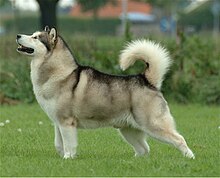
Alaskan Malamute
Malamutes are large, strong freight-type dogs.[1] They weigh between 36 and 54 kilograms (80 and 120 lb) and have round faces with soft features.[1] Freight dogs are a class of dogs that includes both pedigree and non-pedigree dogs.[1] Malamutes are thought to be one of the first domesticated breeds of dogs, originating in the Kotzebue Sound region of Alaska.[19] These dogs are known for their broad chests, thick coats, and tough feet.[1] Speed has little to no value for these dogs - instead, the emphasis is on pulling strength.[1] They are used in expedition and long adventure trips, and for hauling heavy loads.[1] Malamutes were the dog of choice for hauling and messenger work in World War II.[19]

Canadian Eskimo Dog
Also known as the Exquimaux Husky, Esquimaux Dog, and Qimmiq, the Canadian Eskimo Dog has its origins in the aboriginal sled dogs used by the Thule people of Arctic Canada.[20] The breed as it exists today was primarily developed through the work of the Canadian government.[20] It is capable of pulling between 45 and 80 kilograms (99 and 176 lb) per dog for distances between 24 and 113 kilometres (15 and 70 mi).[20] The Canadian Eskimo Dog was also used as a hunting dog, helping Inuit hunters to catch seals, muskoxen, and polar bears.[20]
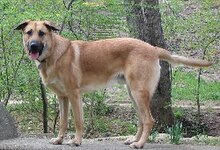
Chinook
The Chinook is a rare breed of sled dog developed in New Hampshire in the early 1900s, and is a blend of Mastiff, Greenland Dog, German Shepherd, and Belgian Shepherd.[21] It is the state dog of New Hampshire and was recognized by the AKC as a Working breed in 2013.[21] They are described as athletic and "hard bodied" with a "tireless gait".[21] Their coat color is always tawny, ranging from a pale honey color to reddish-gold.

Greenland Dog
Eskimo dogs that originated in Greenland, Greenland Dogs are heavy dogs with high endurance but little speed.[1] They are frequently used by people offering dog sled adventures and long expeditions.[1] There are more than 30,000 Greenland Dogs living in Greenland.[22] In the winter, they are a primary mode of transportation.[22] Most hunters in Greenland favor dog sled teams over snowmobiles, as the dog sled teams are more reliable.[22]

Samoyed
The Samoyed was developed by the Samoyede people of Siberia, who used them to herd reindeer and hunt, in addition to hauling sleds.[23] These dogs were so prized, and the people who owned them so dependent upon them for survival, that the dogs were allowed to sleep in the tents with their owners.[23]

Siberian Husky
Smaller than the similar-appearing Malamute, the Siberian Husky pulls more, pound for pound, than a Malamute, but cannot pull as long.[1] They weigh between 18 and 27 kilograms (40 and 60 lb), and have been selectively bred for both appearance and pulling ability.[1]
Other breeds
Numerous non-sled dog breeds have been used as sled dogs. Poodles,[24] Irish Setters,[1] German Shorthaired Pointers,[1] Labrador Retrievers,[1] Newfoundlands,[7] Chow Chows and St. Bernards[7] have all been used to pull sleds in the past.
World Championships
FSS held the first World Championships (WCh) in Saint Moritz, Switzerland in 1990 with classes in only Sled Sprint (10-Dog, 8-Dog, and 6-Dog) and Skidog Pulka for men and women. 113 competitors arrived in the starting chutes to mark the momentous occasion. At first World Championships were held each year, but after the 1995 events, it was decided to hold them every two years, which facilitated the bidding process and enabled the host organization more time for preparation.[25]
Famous sled dogs
Togo
Togo was the lead sled dog of Leonhard Seppala and his dog sled team in the 1925 serum run to Nome across central and northern Alaska.
Balto
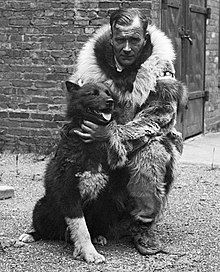
Balto was the lead dog of the sled dog team that carried the diphtheria serum on the last leg of the relay to Nome during the 1925 diphtheria epidemic.[26] He was driven by musher Gunnar Kaasen, who worked for Leonhard Seppala.[26] Seppala had also bred Balto.[26]
In 1925, 10 months after Balto completed his run,[27] a bronze statue was erected in his honour in Central Park near the Tisch Children's Zoo.[28] The statue was sculpted by Frederick George Richard Roth.[28] Children frequently climb the statue to pretend to ride on the dog.[28] The plaque at the base of the statue reads "Endurance · Fidelity · Intelligence".[28] Balto's body was stuffed following his death in 1933, and is on display at the Cleveland Museum of Natural History.[26]
In 1995, a Universal Pictures movie based on his life, Balto, was released.[26] Roger Ebert gave it three out of four stars.[29]
Other dogs
Anna was a small sled dog who ran on Pam Flower's team during her expedition to become the first woman to cross the Arctic alone.[30] She was noted for being the smallest dog to run on the team, and a picture book was created about her journey in the Arctic.[30]
There are numerous stories of blind sled dogs that continue to run, either on their own or with assistance from other dogs on the team.[18][31]
Sled dogs in popular culture
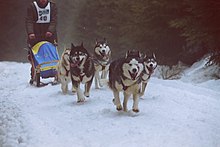
Literature
Sled dogs have been written about extensively by numerous authors.
- My Dogs in the Northland (1902) by Egerton Ryerson Young focuses on Egerton's adventures with a team of 12 sled dogs.[32]
- The Call of the Wild (1903) by Jack London is a famous work of fiction about sled dogs and their lives in the Gold Rush era; it used Young's book as a source.
Movies
- Call of the Wild (1935)
- Balto (1995)
- Snow Dogs (2002)
- Eight Below (2006)
- Sun Dogs (2006)
- Snow Buddies (2008)
See also
References
- ^ a b c d e f g h i j k l m n o p q r s t u v Cary, Bob (2009). Born to Pull: The Glory of Sled Dogs. Illustrated by Gail De Marcken. Minneapolis, Minnesota: U of Minnesota Press. pp. 7–11. ISBN 081666773X.
- ^ Pitulko, Vladimir V.; Kasparov, Aleksey K. (2017). "Archaeological dogs from the Early Holocene Zhokhov site in the Eastern Siberian Arctic". Journal of Archaeological Science: Reports. 13: 491. doi:10.1016/j.jasrep.2017.04.003.
- ^ Marquard-Petersen, Ulf (2011). "Invasion of eastern Greenland by the high arctic wolf Canis lupus arctos". Wildlife Biology. 17 (4): 383. doi:10.2981/11-032. Note: These figures are in the past because this was the time period of interest for the wolf research conducted.
- ^ a b c d e f g h i j k l m n o p "Sled Dogs in the North". Yukon Quest Sled Dogs. Yukon Quest. Retrieved February 15, 2013.
- ^ Martin, Elizabeth Libbie (2012). Yukon Quest Sled Dog Race. Mount Pleasant, South Carolina: Arcadia Publishing. p. 11. ISBN 0738596272.
- ^ a b c d Huson, Heather J; Parker, Heidi G; Runstadler, Jonathan; Ostrander, Elaine A (July 2010). "A genetic dissection of breed composition and performance enhancement in the Alaskan sled dog" (PDF). BMC Genetics. 11: 71. doi:10.1186/1471-2156-11-71. PMC 2920855. PMID 20649949.
{{cite journal}}: CS1 maint: unflagged free DOI (link) - ^ a b c d e f g h i j Hegener, Helen (June 2, 2011). "Dogsled mail in Alaska". Alaska Dispatch. Retrieved February 18, 2013.
- ^ a b c d e f g h i j k l Young, Ian (2002). The Iditarod: Story of the Last Great Race. Illustrated by Timothy V. Rasinski. Capstone Classroom. pp. 5–13. ISBN 073689523X.
- ^ a b c d e f g h i "The Modern Sled Dog". Yukon Quest Sled Dogs. Yukon Quest. Archived from the original on December 26, 2013. Retrieved February 15, 2013.
- ^ "The Sledge Dogs of the North". Outing: Sport, Adventure, Travel, Fiction. W. B. Holland. 1901. pp. 130–137. Retrieved 4 March 2013.
- ^ a b c d e Lew Freedman; DeeDee Jonrowe (1995). "Introduction". Iditarod Dreams: A Year in the Life of Alaskan Sled Dog Racer DeeDee Jonrowe. Epicenter Press. pp. 11–15. ISBN 978-0-945397-29-8. Retrieved 27 February 2013.
- ^ a b Lew Freedman; DeeDee Jonrowe (1995). "The Race Is On". Iditarod Dreams: A Year in the Life of Alaskan Sled Dog Racer DeeDee Jonrowe. Epicenter Press. pp. 25–33. ISBN 978-0-945397-29-8. Retrieved 27 February 2013.
- ^ Lew Freedman; DeeDee Jonrowe (1995). "The Starting Line". Iditarod Dreams: A Year in the Life of Alaskan Sled Dog Racer DeeDee Jonrowe. Epicenter Press. pp. 17–23. ISBN 978-0-945397-29-8. Retrieved 27 February 2013.
- ^ Janet Woolum (1998). "Susan Butcher (dog-sled racer)". Outstanding Women Athletes: Who They Are and How They Influenced Sports in America. Greenwood Publishing Group. pp. 94–96. ISBN 978-1-57356-120-4. Retrieved 27 February 2013.
- ^ a b c d e f g h i j k l m n o p q r s t u v w x y William J. Mills (2003). Exploring Polar Frontiers: A Historical Encyclopedia. ABC-CLIO. pp. 189–192. ISBN 978-1-57607-422-0. Retrieved 27 February 2013.
- ^ Douglas Mawson. "The Home of the Blizzard".
- ^ a b c "Sled Dogs: An Alaskan Epic". PBS. November 1999. Retrieved February 15, 2013.
- ^ a b c Person, Stephen (2011). Sled Dogs: Powerful Miracle. Bearport Publishing. pp. 4–10. ISBN 1617721344.
- ^ a b Betsy Sikora Siino (January 2007). Alaskan Malamutes. Barron's Educational Series. pp. 6–7. ISBN 978-0-7641-3676-4. Retrieved 27 June 2013.
- ^ a b c d "Canadian Eskimo Dog". New Zealand Kennel Club. Retrieved 2013-04-11.
- ^ a b c "AKC Recognizes Two New Breeds for 2013". Dog Channel. February 20, 2013. Retrieved 2013-04-11.
- ^ a b c Human Planet – Arctic: Greenland sled dogs (Video). ABC1. March 10, 2011.
- ^ a b "Get To Know The Samoyed". Meet The Breed. American Kennel Club. Retrieved 2013-04-11.
- ^ Thornton, James S. (March 7, 1988). "The Very Latest In Mushing: Poodle-powered Sleds". Sports Illustrated. Retrieved 2013-06-27.
- ^ "History - International Federation of Sleddog Sports". www.sleddogsport.net. Retrieved 28 March 2018.
- ^ a b c d e "Sled Dogs: An Alaskan Epic: Balto". Nature. PBS. Retrieved March 4, 2013.
- ^ "Balto". Things To See. Central Park Conservancy. Retrieved March 4, 2013.
- ^ a b c d "Balto". Attractions. Central Park.Com. Retrieved March 4, 2013.
- ^ Ebert, Roger (December 22, 1995). "Balto". rogerebert.com. Retrieved March 4, 2013.
- ^ a b Pam Flowers; Ann Dixon (1 September 2003). Big-Enough Anna: The Little Sled Dog Who Braved The Arctic. Graphic Arts Center Publishing Co. ISBN 978-0-88240-580-3. Retrieved 27 February 2013.
- ^ The Associated Press (January 25, 2013). "Gonzo, blind sled dog in New Hampshire, thrives in sled races with brother's help". New York Daily News. Retrieved February 18, 2013.
- ^ Young, Egerton Ryerson (1902). My Dogs in the Northland (eBook) (3 ed.). F.H. Revell Company. p. 9. Retrieved 16 May 2013.
For years, with great dogs, I toiled and often with them was in great perils. Much of my work was accomplished by their aid. So I believe in dogs, and here in this book I have written of some of them and their deeds.

